February 11, 2011
Air Date: February 11, 2011
FULL SHOW
SEGMENTS
House Republicans Fight EPA over Greenhouse Gases
View the page for this story
The Republican-chaired House Energy and Commerce Committee wants to wrestle power from the Environmental Protection Agency. But the former committee chair, California Democrat Henry Waxman, maintains that the science of climate change should not be a partisan issue. He tells host Bruce Gellerman why the laws of nature can't be negotiated. (06:45)
Amazon Forest as a Source of Carbon Dioxide
View the page for this story
In 2005, the Amazon experienced a once-in-a-century drought. Just five years later, the drought was even worse. University of Leeds Professor Oliver Phillips tells host Bruce Gellerman that such extreme droughts cause the Amazon to be a source of carbon dioxide instead of a carbon sink. (05:15)
Toxic Tide: Discovering the Health Effects of the Deepwater Disaster
/ Jeff YoungView the page for this story
Months after BP's well was capped, the health effects of the Deepwater Horizon oil spill may just be starting to surface. Residents across the Gulf Coast report mysterious ailments, and some blood samples show traces of chemicals related to the oil. But as Living on Earth's Jeff Young reports, firm answers are hard to come by and frustration is growing in coastal communities. (09:30)
Homeground: The Language of Landscape
/ Barry LopezView the page for this story
In our continuing series on language of the American landscape from the book "Home Ground," editor Barry Lopez defines the term "acre foot." (01:45)
Mixing Oil and Water
/ Jeremy MillerView the page for this story
Tar sands oil from northern Alberta is notoriously dirty and difficult to get out of the ground and refine. But it turns out California has its own thick and dirty oil. As reporter Jeremy Miller tells host Bruce Gellerman, California is using clean, fresh water, turned to steam, to get that petroleum out of the ground. (06:20)
Trash to Treasure
View the page for this story
In rural Guatemala, communities are working together to collect trash and plastic bottles to use as building materials. Former Peace Corp volunteer Laura Kutner tells host Bruce Gellerman that projects like this are a win-win: villages are cleaner and children get new schools. (05:00)
Science Note
/ Wynn TuckerView the page for this story
Researchers discover that the Oriental Hornet can convert sunlight into energy. Scientists look to imitate the insect's body structure and apply it to solar technology. Wynn Tucker reports. (01:35)
The Poetry of the Ocean
/ Ari Daniel ShapiroView the page for this story
You might think that science and poetry are, well, like oil and water. But Oceanography Professor John Delaney of the University of Washington is on a mission to blend science and poetry to achieve a deeper understanding of our planet. Reporter Ari Daniel Shapiro reports. (08:10)
This week's EarthEar selection
listen /
download
At Antelope Island State Park in Utah, producer Jeff Rice records the sounds of wild bison.
Show Credits and Funders
Show Transcript
HOST: Bruce Gellerman
GUESTS: Henry Waxman, Oliver Phillips, Jeremy Miller, Laura Kutner.
REPORTERS: Jeff Young, Wynn Tucker, Ari Daniel Shapiro, Barry Lopez.
[THEME]
GELLERMAN: From Public Radio International - this is Living on Earth. I'm Bruce Gellerman. House Republicans grill the EPA administrator and introduce a bill to strip the agency of its authority to regulate greenhouse gases.
WAXMAN: The very premise of this legislation is that the science is a hoax, in fact we start off the hearing with Senator Inhofe who told us he's writing a book and he's going to call it “Hoax”.
GELLERMAN: Coming up: the laws of Congress versus the laws of nature. Also - part one in our special series: "Toxic Tide - Discovering the Health Effects of the Deepwater Disaster.”
MILLER: I worked 60 days on the frontline for BP out here. I'm sick today. Nobody wants to take care of me.
FOYTLIN: We are very, very ill, and there's a very good chance now that I won't get to see my grandbabies.
GELLERMAN: Many Gulf residents are now ill and blame the BP oil spill for their symptoms. Those stories just ahead on Living on Earth - stick around!
[THEME]
House Republicans Fight EPA over Greenhouse Gases
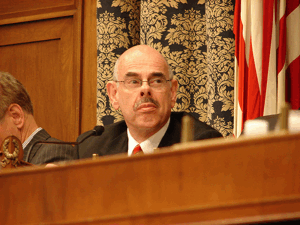
Congressman Henry Waxman (D-Calif), previously the chair -- and now ranking member -- of the House Energy and Commerce Committee. (Photo: Bridgette Blair)
GELLERMAN: From the Jennifer and Ted Stanley Studios in Somerville Mass, this is Living on Earth. I'm Bruce Gellerman. Tune in to a daytime soap opera and you get melodrama, accusations, and denials - but if you sat through a recent daylong congressional hearing, you'd get that and more. The hearing, held by the Republican controlled House Energy and Power subcommittee, featured EPA administrator Lisa Jackson as the star witness. She was called to defend her agency's plans to regulate greenhouse gases.
Four years ago the US Supreme Court ruled the EPA has the authority under the Clean Air Act to reduce climate-changing emissions - but now House republicans have introduced a bill that would prevent the Agency from taking action. Democrat Henry Waxman, the ranking minority member on the committee, had a front row seat at the dramatic hearing.
WAXMAN: The very premise of this legislation is that the science is a hoax, in fact we start off the hearing with Senator Inhofe who told us he's writing a book and he's going to call it “Hoax,” because he thinks that the work of the National Academy of Sciences and all the scientific agencies that have been looking at the carbon problem are perpetrating a hoax on the American people. And it's amazing to me that the idea of science should be partisan.
GELLERMAN: Well, Republican Congressmen John Shimkus of Illinois said in his remarks, he said, "This is about jobs, this isn't about science."
WAXMAN: If we would have done something to reduce the carbon emissions as we had proposed last year, we would have created millions of new jobs. We would be way ahead of the other countries in the world that are further along than we are, producing ways to deliver energy without the pollution from carbon.
And the main thrust of the proposals by EPA is to require reductions in emissions through efficiency. And anytime industry becomes more efficient, it becomes more competitive and we produce more jobs. So I think that a lot of the Republicans, they think they're doing these industries a favor by trying to keep the status quo and stop anything from happening. I think they're doing a disservice to the American people who want jobs, cheaper energy, less dependent on foreign oil, and an environment that is going to be protected, not thrown into disregard.
GELLERMAN: Well, you obviously see it much differently than Republican Representative Joe Barton, who, in his opening remarks said, quote, “The EPA and the Obama Administration have decided that they want to put the American economy in a straight-jacket, costing us millions of jobs and billions of dollars a year.”
WAXMAN: Well, I think that's an astonishing statement. I guess I have to look back at 36 years in the Congress. From the first day I arrived here in 1975, I sat through hearings on the Clean Air Act, where industry after industry testified that they thought any environmental laws would hurt them, and would hurt our economy and cost us jobs.
And the history of the Clean Air Act since 1970, and especially since the 1990 amendments to it, have been exactly the opposite. Our businesses have been more competitive, our environment has been cleaner, and we've had the economy grow and more jobs as well, and sometimes as a result.
GELLERMAN: This hearing was about a Republican introduced measure called the “Energy Tax Prevention Act,” and basically this would stop the EPA from regulating greenhouse gases.
WAXMAN: Well, the title is the first misleading aspect of the legislation, because EPA cannot impose a tax. They use that word ‘tax' because they know that people don't like taxes. But when you look at what they're trying to do, they didn't want to pass the legislation to deal with global warming, climate change - they fought against that in the last year. And now that the EPA is acting under the existing law, as required by a five-to-four Supreme Court decision in interpreting the law, they want to stop the EPA from acting.
And they not only want to do that, they want to stop California and other states from tightening down on auto emissions in the future. In effect, they want nothing to be done. This is a very extreme, very extreme measure. And I can't imagine that it'll get through all the way to the President or, if it got that far, he wouldn't veto it.
GELLERMAN: Before the hearing, you sent a letter to the chairman of the full committee, Fred Upton, that was from Steve Johnson, who was the EPA administrator under the George W. Bush administration. And he says in that letter, that the EPA should regulate greenhouse gases under the Clean Air Act.

Former EPA administrator Stephen Johnson told President George W. Bush that the EPA should regulate greenhouse gas emissions, according to documents revealed from Congressman Waxman's investigation.
WAXMAN: Yes, and he wrote to the President of the United States saying that the science requires them to make this finding and to do the regulations under the Clean Air Act. So he wanted to do something and he felt he had to do something because the science required it. Now the Republicans are saying that the science is a hoax, and that the EPA shouldn't have the ability to regulate, even though the court has said that they must.
And what we wanted to point out was: even in the Bush Administration, the head of the EPA, the administrator Stephen Johnson, came to the same conclusions as Lisa Jackson, the existing administrator at EPA. So this is not a partisan conclusion, although Mr. Johnson certainly got the signal from the Bush White House that they didn't want him to go forward, so he didn't move anymore than just simply indicate that the White House, and he was going to reach an endangerment finding.
So, we pointed that outÂ…I think it's important for the American people to figure out that this is not some Democratic party Obama Administration plot, it's what the science and it's what the law requires. They could maybe change the law if the Republicans want to, but they can't amend the laws of nature, and they can't decide that science doesn't count and not have the impact that we know is going to continue with all of the accumulation of the carbon emissions in our atmosphere.
Related links:
- Learn more about the energy and environment views of Congressman Fred Upton, chair of the House Energy and Commerce Committee.
- Click here to read Johnson's letter to President Bush.
GELLERMAN: Henry Waxman is a democrat from California and the ranking member of the House Energy and Commerce Committee.
Amazon Forest as a Source of Carbon Dioxide
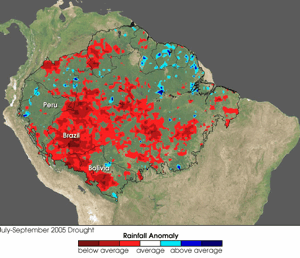
Red regions on this map of the Amazon show areas of below average rainfall in 2005. (Photo: NASA)
GELLERMAN: Well, while Congress debates the laws of man, climate scientists continue to investigate the laws of nature. In the Amazon forest researchers are trying to calculate the damage from 2 severe droughts.
In recent years there's been a distinct lack of rain in the Amazon rainforest. “The drought of the century” is what they called the first in 2005, but the second, just 5 years later, was even worse. The forest is drying and the trees are dying, destroying the vast region’s ability to absorb carbon from the atmosphere. University of Leeds researcher Oliver Phillips says instead of acting as a carbon sink, the Amazon forest is becoming a huge source of climate changing gases.
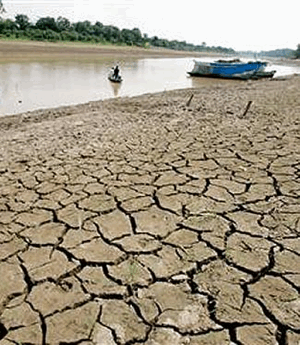
In 5 years the Amazon has experienced 2 extremely severe droughts. (Earth Week)
PHILLIPS: In 2005, we think the Amazon lost about 1 billion tons of carbon. What droughts do is they - theyÂ’ve killed trees. As all that dead wood decays, that gets converted into carbon dioxide, and thatÂ’s what then goes to the atmosphere. So, what happened - the 2005 drought, what it did was actuallyÂ…it stopped the sink, it flipped it the other way to a source, and it increased the magnitude by two. So it went from a moderate sink to a strong source as a result of 2005.
GELLERMAN: Whoa!
PHILLIPS: Yeah, so it was a big impact. A billion metric tons is close to the emissions of all the cars on earth at the moment. In other words, the amount of CO2 that theyÂ’re emitting was actually a little bit less than the impact of the 2005 drought. So, the question now after the 2010 drought, which was bigger in climatological terms than 2005, is: did that also kill trees? And we suspect, based on our 2005 analysis, that 2010 will have killed even more trees and have caused even more carbon to be emitted to the atmosphere.

Red regions on this map of the Amazon show areas of below average rainfall in 2005. (Photo: NASA)
GELLERMAN: Really what we are looking at here is kind of a giant feedback loop - the more drought we have, the more trees die, which will lead to more droughtÂ…
PHILLIPS: Well, there are lots of possible interactions in the system. Now, one of them is the system gets drier then growth may decline and the death of trees may accelerate, so you get release of carbon to the air, and that in turn, etc., is climate change. And we expect that the changing climate this century will act to strengthen the dry season, particularly across the southern Amazon. So the kind of droughts we are seeing now - they are consistent with the global climate change picture.
GELLERMAN: Do these intense droughts - do they affect the composition of the forest? The types of trees that survive?
PHILLIPS: Last time, in 2005, we did find that the drought was actually killing some kinds of trees more than others. On some of the plots it was the palms, which were really suffering. And that kind of makes sense in ecological terms, because these are species which are found mostly in the western, wet part of the Amazon, and tend to drop out in the drier areas.
So the implication is: if we have several of these droughts, one after the other, that would drive some change in the composition - or if you like, the biodiversity - of the system. And of course, naturally, we would expect that those kinds of trees which are more resilient to drought may turn out to be the winners if this process continues.
GELLERMAN: But those trees which you call winners - are they good at absorbing carbon - lots of carbon? Or are the losers the ones that absorb carbon?
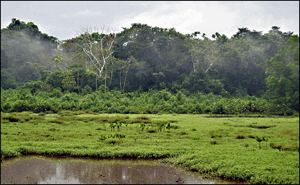
Research shows that the Amazon rainy season is much the same but the dry season is lasting longer. (Photo: NASA)
PHILLIPS: On average the trees in the drier part of the Amazon are a little bit shorter than in the wetter part. So we expect if the forest dries, that the average height of the tree will start to decline. It will change in form in the kinds of species, and some carbon will be lost.
GELLERMAN: The last sentence of your study in Science really sent shivers up my spine, and I’m going to quote, it says, “If drought events continue, the era of intact Amazon forest buffering the increase in atmospheric carbon dioxide may have passed.” In other words, if we have more droughts, then the Amazon’s ability to absorb more carbon dioxide is over.
PHILLIPS: Yeah, yup. ThatÂ’s possible. I mean, when you think about the implications of that, itÂ’s really - the earth is a big place, obviously, and itÂ’s not just the Amazon which is important in affecting the rate in which CO2 is increasing in the atmosphere. There are other big carbon sinks tooÂ…thereÂ’s African forest, which is also large, and there are forests in the temperate zone, in the US and in Europe - there are big forest areas which are probably currently absorbing carbon.
And if you add up all of those forest areas around the world, they provide us with a hell of a service so far in slowing down the rate at which CO2 is accumulating in the atmosphere. The scenario for this century now is whatÂ’s going to happen to those carbon sinks. If those sinks slow down and stop, then we can emit that much less carbon dioxide if we want to keep our earth a safe place to live.
GELLERMAN: Oliver Phillips is a professor of Geography at the University of Leeds in the UK, and co-author of the study, “The 2010 Amazon Drought” in Science Magazine.
Related links:
-
- Click Here to Read the Abstract of the Report 2010 Amazon Drought
[MUSIC: Daniela Mercury “Feijao De Corda” from Feijao Com Arroz (Paginas Do Mar 2000).]
GELLERMAN: Just ahead: "Toxic Tide - Discovering the Health Effects of the Deepwater Disaster." Keep listening to Living on Earth!
[MUSIC:“Tricky Dick” from Cowboy Justice (Palmetto Records 2006).]
Toxic Tide: Discovering the Health Effects of the Deepwater Disaster

Wilma Subra looking at sand samples from the Gulf Coast. (Photo: Jeffrey Dubinsky)
GELLERMAN: ItÂ’s Living on Earth, IÂ’m Bruce Gellerman. ItÂ’s been more than six months since BP finally capped its runaway oil well in the Gulf of Mexico. But now come reports of a wave of illnesses and puzzling symptoms from some residents along the Gulf Coast. Their blood contains high levels of chemicals found in oil and the dispersants that were used to clean up the mess.
Many who are suffering say firm answers and adequate treatment are hard to come by, and thereÂ’s a growing sense of frustration with government agencies and the medical community. Living on EarthÂ’s Jeff Young has the first part of our special report: "Toxic Tide - Discovering the Health Effects of the Deepwater Disaster".
[HEARING: OIL SPILL COMMISSIONER DON BOESCH Okay, questions and comments from the floorÂ…]
YOUNG: When the National Oil Spill Commission presented its final report in New Orleans, commissioners expected to get an earful from rig workers and fishermen worried about their jobs. Instead they heard speaker after speaker worried about something else: their health.
SPEAKER 1: I worked 60 days on the frontline for BP out here. IÂ’m sick today, nobody wants to take care of me.
SPEAKER 2: The issue is ongoing; people are getting sick and dying.
SPEAKER 3: I have seen small children with lesions all over their body. We are very, very ill. And thereÂ’s a very good chance now that I wonÂ’t get to see my grandbabies.
YOUNG: Some had worked cleaning up the oil, others lived in or had visited places where oil washed ashore. All complained of mysterious ailments that arose after the spill.

ChildrenÂ’s footprints in the oily sand along the Alabama coast. (Photo: Jerry Cope)
Robin Young was one of those who spoke out. She manages vacation rental properties in Orange Beach, Alabama, where she has lived for 10 years.
When the spill started, Young helped form a citizen group called Guardians of the Gulf. At first, the group was not focused on health issues. Then, people, including Young, started getting sick.
R YOUNG: Headaches, I would get nauseous - and these are all things that I donÂ’t normally experience at all, IÂ’ve always been very, very, very healthy. Then the coughing - I coughed up so much nasty looking mess.
J YOUNG: Young says symptoms started after she spent a day near the water in June and she still hasnÂ’t fully recovered. She heard from others in her community and across the Gulf coast with similar problems.
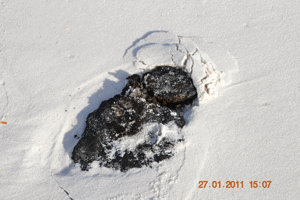
Tarballs of BP crude still come ashore when winter storms stir up the GulfÂ’s remaining spilled oil. (Photo: Jerry Cope)
R YOUNG: We have way too many people that are sick with very odd symptoms that they have never experienced before in their life. So thereÂ’s something going on! And itÂ’s all the way up and down the coast and it seems to be in the predominant areas where the oil continues to come onshore.
J YOUNG: A number of people Young contacted sought treatment just across the state line in Santa Rosa Beach, Florida, with Dr. Rodney Soto. Dr. Soto says heÂ’s seeing a lot of upper respiratory symptoms and severe rashes.
SOTO: Multiple lesions all over their bodies and bruising. I tell you, people are suffering a great degree. The stress level is through the roof. So we are barely scratching the surface in regards to what else we are going to see and I donÂ’t think the medical community is well prepared to handle this.
J YOUNG: Dr. Soto says the symptoms, patient histories and, in some cases, blood samples indicate these illnesses are likely due to chemical exposure from the spill. But back on the Alabama coast, thereÂ’s skepticism about that. Tony Kinnon is mayor of Orange Beach.
KINNON: I would not doubt that these people are ill. But I would say for them to adamantly say the oil spill made them ill - theyÂ’re gonna have to present evidence.
YOUNG: Kinnon says the city contracted an independent engineering firm to sample air water and soil. And he says local physicians have not reported any unusual number of health issues that might be oil-related. He says he wants to protect peopleÂ’s health and peopleÂ’s jobs.

Gulf Coast residents say this foamy mixture of oil and dispersants still comes up in the waves. (Photo: Shirley Tillman)
KINNON: WeÂ’re a tourism industry. And I donÂ’t know if you can remember that old scene in the movie Jaws where the mayor is standing on the beach saying "Come on to the beach, thereÂ’s no shark in the water!" and, heh, you look in the water and thereÂ’s blood everywhere!
YOUNG: You donÂ’t want to be that guy!
KINNON: ThatÂ’s exactly right. So you know, I want people to know that when I say we are healthy, the water and our beaches are fine - itÂ’s because we did our homework.
YOUNG: State health departments in Alabama, Florida, Louisiana and Mississippi set up surveillance systems with emergency rooms and health clinics. There is little in that data to suggest a large number of spill-related illness. But Dr. Rodney Soto says chemical exposure cases can fall through the cracks if physicians are not trained to detect them because the symptoms mimic other illnesses.
SOTO: The diagnoses in their records are gonna be cold, flu, weakness, immune problem, whatever they want to call it. And so the government agencies are not gonna pick up on anything because there is no report or no documentation in the records.
YOUNG: Dr. Soto suspects many people who lack health insurance are trying to treat their own symptoms with over-the-counter medicines. And worse, Dr Soto says, some physicians might be willfully turning a blind eye.
SOTO: And, unfortunately, IÂ’m hearing a lot from patients that their doctors are turning them away. They, for whatever reason, donÂ’t want to get involved with dealing with this connection of oil to illness. Whether itÂ’s litigation, or whether itÂ’s BP, who knows what their motivations are. Somebody specifically told me the doctor said "We donÂ’t want to see any patients who potentially have symptoms of oil spill, period."
YOUNG: Some of Dr. SotoÂ’s patients are having their blood samples analyzed for traces of volatile organic compounds that might indicate oil exposure. Robin Young had her blood tested.
RYOUNG: They found that I had ethylbenzene, isooctane, 2-butyrol, 3-butyrol, the hexane levels were over the top – so the lab even put a big H by it. It was scary; it was depressing. And then I got mad.

Biochemist Wilma Subra presents results of her analysis of blood samples to community members in Louisiana. “There’s a lot of frustration in communities.” Subra said. “They are really requesting answers.” (Photo: Jeffrey Dubinsky)
J YOUNG: YoungÂ’s group paid for more blood sampling. The Louisiana Environmental Action network asked biochemist and MacArthur grant winner Wilma Subra to analyze the results. The blood samples came from cleanup workers, crabbers, a diver whoÂ’d been in oiled water, and at least two children who live on the coast. All had reported recent health problems. Subra compared the levels of volatile organic compounds in those samples to a national database of VOCÂ’s in blood compiled by the National Center for Health Statistics.
SUBRA: TheyÂ’re as much as 5 to 10 times what youÂ’d find in the normal population. And again, these are chemicals that relate back to chemicals in the BP crude and the dispersants.
YOUNG: Benzene is a carcinogen and is linked to immune system problems and a host of illnesses. Ethylbenzene can cause dizziness and kidney damage. Xylene can cause headaches, rashes and respiratory problems.
But this blood sampling alone does not prove a connection between the illnesses and the oil. ItÂ’s a small number of people - just a few dozen. Many of the chemicals rapidly break down and are hard to track. And other routes of exposure might be to blame. Benzene can come from pumping gasoline, breathing paint fumes, vehicle exhaust, or cigarette smoke. But Subra defends her findings and wants health officials to use her data to guide further study and treatment.
SUBRA: I think itÂ’s demonstrating that the chemicals they are being exposed to are showing up in their blood. WeÂ’ve briefed the federal agencies on it, tried to get them interested - they are evaluating the results. And I think thereÂ’s a lot of frustration in the community members across the coastal areas. They are really requesting answers.

Wilma Subra looking at sand samples from the Gulf Coast. (Photo: Jeffrey Dubinsky)
YOUNG: Solid answers will take time. ThereÂ’s little in the scientific literature on long term health effects of oil spills. In March the National Institute of Environmental Health Sciences plans to start enrolling Gulf spill cleanup workers in a long-term health study. The principal investigator is Dale Sandler, chief of epidemiology at NIEHS. She hopes to track some 55,000 subjects for at least five years.
SANDLER: This will be by far the largest study of individuals exposed during an oil spill disaster thatÂ’s ever been conducted. So we have been moving heaven and earth to make this go quickly.
YOUNG: SandlerÂ’s study has funding, thanks in part to BP. The study is a few months behind its original schedule. But researchers face another hurdle that may prove more difficult. Signing up tens of thousands of participants and getting people to accept results depends on credibility and trust. After the BP spill and Hurricane Katrina, trust is in low supply on the Gulf Coast. HereÂ’s how Orange Beach Mayor Tony Kinnon sums up the attitude.
KINNON: The bottom line is very few people trust governmental agencies. They think thereÂ’s this incestuous relationship between BP and the government, and I tend to agree with them.
J YOUNG: And even as Robin Young asks the government to help her community, the plea comes with a note of deep suspicion.
RYOUNG: I hate to sound like a conspiracy theorist - thatÂ’s what IÂ’m starting to feel like. Because itÂ’s hard to believe that something like this is going on in the United States and no oneÂ’s helping.
J YOUNG: Those hoping to find the Gulf spillÂ’s real impact will also have to find a way to bridge a gulf of mistrust. For Living on Earth, IÂ’m Jeff Young.
GELLERMAN: Our special report: "Toxic Tide - Discovering the Health Effects of the Deepwater Disaster" continues next week with JeffÂ’s report on a key scientific finding in the GulfÂ’s air and water.
KALTOFEN: And thatÂ’s where we found something very interesting. It was not the crude oil that was responsible for most of the volatile compounds weÂ’re seeing, but it was actually the dispersant.
GELLERMAN: ThatÂ’s next week on Living on Earth.
Related links:
-
- The NIEHS plan for a large-scale, long-term study of cleanup workers.
-
- Orange Beach, Ala., environmental sampling data
[MUSIC - HOME GROUND THEME: Daniel Lanois “O Marie” from Acadie (Red Floor Records 2008)]
Homeground: The Language of Landscape
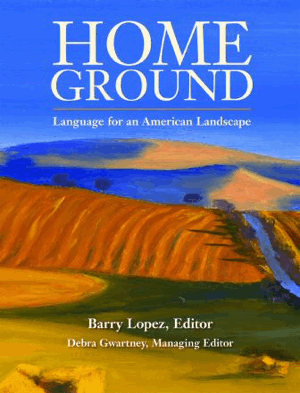
Home Ground: Language for an American Landscape, edited by Barry Lopez and Debra Gwartney. (Courtesy of Trinity University Press)
GELLERMAN: Just ahead - a story about mixing oil and water in the California desert. In that story you’ll hear a term not commonly used: acre-foot. For a definition we turn to the book “Home Ground.” It’s an anthology of expressions that describe, explain and illuminate our landscape. The editor is Barry Lopez.
LOPEZ: Acre-foot. In a landscape where porcupines lead undisturbed lives, every attentive resident knows how far you mean when you say something is “two porcupines away.” It’s twice the breadth of what one’s come to know as a single porcupine range. Similarly, we learn to quickly locate a feature on the horizon if someone says, ‘it’s a thumbnail to the left of the highest peak there.’

Home Ground: Language for an American Landscape, edited by Barry Lopez and Debra Gwartney. (Courtesy of Trinity University Press)
Folk measurements like these - or the stoneÂ’s-throw, the dayÂ’s ride, or the pace, though not precise, are accurate. The acre-foot joins together two once imprecise folk measurements to create a term that, apparently, leaves nothing to interpretation. ItÂ’s exactly 43,560 cubic feet of water - a single acre, one foot deep. Given the behavior of water, however, such a precision is rarely dead accurate, which accounts for the enduring wisdom behind the use of folk measurements.
[MUSIC]
GELLERMAN: Nature writer Barry Lopez lives on the McKenzie River in western Oregon. His definition of acre-foot is from the book “Home Ground: Language for an American Landscape,” which he edited with Debra Gwartney.
[MUSIC]
Related link:
The Home Ground Project
Mixing Oil and Water
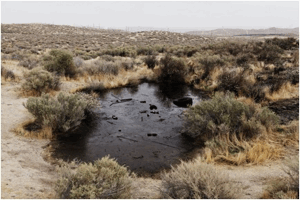
A natural oil seep near McKittrick, CA. (Photo: Todd D'Addario)
GELLERMAN: The movie “There Will Be Blood” is set in the desert scrubland of southern California, at the turn of the 19th - 20th century. The story is fiction but many of the events in this tale of family, greed, and oil are based on fact.
[SFX: SOUND FROM THE MOVIE “THERE WILL BE BLOOD”:…there’s a whole ocean of oil under our feet…no one can get at it except for me…]
GELLERMAN: Once, petroleum did gush from wells in the desert sands of southern California, but today, what’s left of the ocean of oil in some parts of this arid region is gooey crude. In places it’s so thick it has to be mined - thinned out with steam.
Problem is: this is one of the most water-starved corners of the country.
Reporter Jeremy Miller traveled to southwestern San Joaquin Valley. His article “The Colonization of Kern County: a story of oil and water” appears in the latest issue of Orion Magazine.
MILLER: When you are driving around, there is oil literally bubbling up from the ground in places if you know where to look. It’s typical, kind of desert, arid, southwest San Joaquin Valley kind of area.
Yeah, it’s a landscape of oil, for sure. And, it’s interesting because it butts up right against all of the big agricultural regions in the southern San Joaquin Valley.
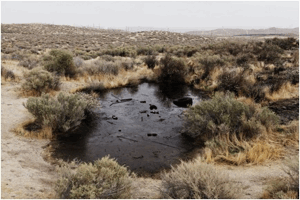
A natural oil seep near McKittrick, CA. (Photo: Todd D'Addario)
GELLERMAN: But the type of oil they’re extracting now is not this gusher oil, it’s more this thick, heavy stuff.
MILLER: It is, yes. One oil driller that I talked to there described it as the consistency of ‘liver in a meat case.’ It’s very thick, gooey, molasses-y, kind of oil. And, that’s a result of the oil sitting in shallow deposits underground and being exposed to air and bacteria– and these bacteria like to chomp on the oil and through that process, the oil gets broken down from the nice stuff that flows like syrup to this sort of semi-solid material.
GELLERMAN: But to extract this type of oil, they have to use prodigious amounts of water - in the form of steam.
MILLER: They do. Yeah, water was a key to unlocking the heavy oil deposits of Kern County. So they’re taking this relatively clean water out of the California aqueduct, and putting it through co-generation plants, which create steam. And they pump it underground, and they use that steam to extract oil. And since that method, called steam flooding, was pioneered back in the 1960’s, most of the oil fields in that area have transferred over to this mode of oil production.
GELLERMAN: So where are they getting all of this water that they use for extracting the oil?

Steam pipes in the Cymric oil field, Kern County, CA. (Photo: Todd D'Addario)
MILLER: So that’s a very good question, and that’s at the heart of my reporting. What I found is that a good portion of the water that oil companies use for steam flooding is coming from the state water project. The state water project administers the California Aqueduct, which is this vast concrete river of water that brings water from the Sacramento, San Joaquin Bay Delta outside of San Francisco, down, all the way to Los Angeles.
So this is not only bringing water to irrigate farms in the central valley, but also bringing drinking water to Los Angeles, Bakersfield, and the other large municipalities in the central valley. So I thought, well, could it be possible that some of this water is coming through the state water project?
And I called Kern County Water Agency, one of the big water distributors in the state - in fact in the world - they are in command of about a million acre-feet of water. I called the water district that serves the main part of the oil fields - it’s the West Kern Water District - and asked the director, JD Bramlet, "Are the oil companies taking water from the state water project through the West Kern Water District to do steam flooding?"
And he told me, "Yeah, they get most of it." And I said, "Well when you say most of it, how much?" And he said, "About 83 percent of the West Kern Water District’s water," which is about 31,000 acre-feet. So, in this parched, dry region, about 83 percent of the water being delivered through the California aqueduct, through one water district alone, is being given to oil companies for steam-flooding operations.
GELLERMAN: So they’re using clean drinking water to extract oil from tar sands?
MILLER: They are, yeah. One of the hiccups of steam flooding, if you will, is that they can’t just use any water to do it. It’s sort of like your coffee maker. If you use dirty water in your coffee maker, you’re going to get stuff precipitating out onto the heating elements of your coffee makers. So the oil companies need a clean, fresh source of water.
One shocking thing that I found in my research is that back in 1985 when oil was at its peak in California, in Kern County it took about four and a half barrels of water to generate one barrel of oil. Okay, four and a half barrels of fresh water to generate one barrel of oil. Well, that oil field is in decline now. Today it takes close to eight barrels of water to generate one barrel of heavy oil. It’s enough water to supply 200,000 households, or about 500,000 people, for a year.
GELLERMAN: From reading your article, this is an area where the aqueduct carrying clean drinking water goes right past towns that don’t have clean drinking water.
MILLER: Exactly. There are dozens of small towns within sight of the aqueduct, as you say, that don’t have access to clean drinking water. So that water flows right past to the oil fields and these towns are forced to deal with well water that they have, which in a lot of cases is contaminated with agricultural pollutants and other natural pollutants.
Yeah, it’s a landscape that’s defined by drought. It’s a semi-arid desert. I mean, this is an area, where, like you say, every drop of water counts.
GELLERMAN: You know, it’s really disturbing to read and think that our addiction to oil, or our need for oil, is so great that we would use water - water that’s scarce - to extract oil from the ground.
MILLER: Yeah, it’s shocking. There’s no other way to put it. And when you’re driving in the area, when you’re walking around in these dry hill sides, it really comes into focus - when you realize that all those miles worth of silver pipes are carrying a vast amount of super-heated steam to get this oil up out of the ground.
GELLERMAN: Well, Jeremy Miller, thanks a lot, I really appreciate it.
MILLER: Thank you so much. I appreciate it.
GELLERMAN: Jeremy Miller’s report, “The Colonization of Kern County: a story of oil and water,” appears in the latest edition of Orion magazine.
Related links:
- Jeremy Miller story in Orion magazine
- EPA page on Crude Oil and Gas Special Wastes
- Industry group The Produced Water Society
- US Fish & Wildlife photos: Hazards to wildlife from oil discharge ponds
- Argonne National Labs paper on Produced Water in the U.S.
- Halliburton link on Composition of Heavy Oil
- West Kern Oil Museum for info on the region's history
- California Division of Oil, Gas, and Geothermal stats on oil and gas
[MUSIC: Bob Marley “Burnin And Lootin” from Capitol Records Rehersal 1973 (EMI 2000).]
GELLERMAN: Just ahead – Okay, all together now: 8 thousand bottles of trash on the wall, 8 thousand bottles of trash… Stay in tune - to Living on Earth!
Support for the environmental health deask at Living on Earth comes from the Cedar Tree Foundation. Support also comes from the Richard and Rhoda Goldman Fund, for coverage of population and the environment. And from Gilman Ordway for coverage of conservation and environmental change. This is Living on Earth.
[MUSIC: Monty Alexander: “Running Away” from Stir It Up: The Music Of Bob Marley (Telarc Records 1999).]
Trash to Treasure
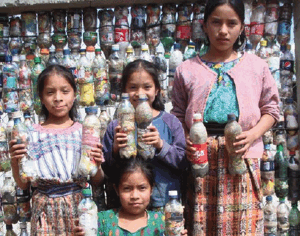
Students in Guatemala showing their hard work. (Photo: Hug it Forward)
GELLERMAN: ItÂ’s Living on Earth, IÂ’m Bruce Gellerman. There are ships IN bottles. Now, there are schools OUT of bottles. In Grenados, Guatemala, kids are learning the 3 RÂ’s - reading, writing and recycling. TheyÂ’ve learned how to turn plastic bottles into walls for their schools. Laura Kutner from Portland, Oregon helped make it happen. She recently returned from Grenados in central Guatemala where she served in the Peace Corps.
A video of children in Guatemala building a school from bottles.
KUTNER: When I first arrived, I was working in the mornings with this elementary school, and there was this metal frame that was just sitting there. And, the principal asked me, she said, "Can you help us find funding to finish these two classrooms? This frame was built for two extra classrooms."
And I said, "Well, absolutely." And about that same time, I had heard about the work of a fellow volunteer. Basically, they turn plastic bottles and inorganic trash into building blocks. It was almost an accident - I was hanging out at recess with some of my students and I was drinking a Coca-Cola and it was in a 600mL bottle, and I realized that the bottle was the exact width of the metal frame that was sitting there.

Students in Guatemala showing their hard work. (Photo: Hug it Forward)
And so a little lightbulb went off in my head and I thought, well, maybe we could apply this construction technique of building out of bottles with this metal frame, and perhaps it will be, you know, a more cost-efficient way of finishing these classrooms.
GELLERMAN: Are these no-deposit, no-return bottles? Or are these bottles that you have a deposit and you get money for them?
KUTNER: Well, there’s no recycling system, unfortunately, in this part of the country. Guatemala as well as, you know, many countries around the world, has issues with waste management. There did exist the mentality of not being necessarily aware of how long it takes trash to decompose, and so a lot of times the plastic bottles and trash were just thrown on the ground – and it was just sitting there.
GELLERMAN: How many bottles did you have to collect?
KUTNER: We calculated that we needed to collect 6,000 bottles, but we ended up using over 8,000.
GELLERMAN: Whoo! ThatÂ’s a lot of bottles!
KUTNER: Yes. Lots of bottles.
GELLERMAN: WhereÂ’d you get them from?

Bottle building construction methods. (Photo: Hug it Forward)
KUTNER: We went to all of the local schools asking for their collaboration. So essentially, every student collected and stuffed at least five bottles. And these have to be stuffed to the max. They are called eco-bricks. And we walked around with the students and we literally cleaned the entire town. We picked up so much trash we had to go to neighboring suburbs to find more trash.
GELLERMAN: How much trash does this equate to?
KUTNER: Each bottle, and it varies a lot based on what kind of inorganic trash - all of the trash has to be inorganic. We had all of the local stores donate all of their plastic trash. You canÂ’t use any paper or cardboard because that decomposes quickly. You know, on average, a bottle weighs about a pound, so if youÂ…8,000 pounds is for one school.
GELLERMAN: So you picked up the bottles, you picked up the trash, you stuffed the trash into the bottles and then built a wall.
KUTNER: We built four walls. ItÂ’s a very simple process. Essentially, you have your frame, and you start on one side of the frame, you have to lay out eitherÂ…you know, you staple chicken wire to one side or what we did, because we used metal, was we tied with metal wire the chicken wire to one side first, and made it really, really tight.
And then you start on the inside and you are stacking the bottles against the first layer of chicken wire vertically and then horizontally, and then youÂ’re slowly closing it over with another layer of chicken wire and then tying both layers of chicken wire together.
So you kind of encage the bottles. And then you put three layers of cement on both sides. After that, you canÂ’t even tell that it was built out of bottles. It looks like it was built out of cement block.

A finished bottle school looks like any other cement building. (Photo: Hug it Forward)
GELLERMAN: Guatemala is a very active earthquake area - can these withstand earthquakes?
KUTNER: Absolutely. Because of the chicken wire and the way that itÂ’s built, itÂ’s actually a little more flexible in earthquake territory than cement block.
GELLERMAN: So whatÂ’s the potential for this kind of method in other parts of the world?
KUTNER: This has huge potential. Since our project has been completed, I have received email inquiries and questions from all over the world - from Haiti, from the Philippines, from Africa - people that are working and want to turn trash into building blocks.
But we always say that these projects, the actual structure - thatÂ’s just one aspect of it. The real long-term goal of these projects is the educational aspect to it, because this is not a long-term solution to trash management in any way, but just the educational aspect in learning how long it takes trash to decompose and what you can do with trash, and how much we produce. We produce enough trash to build buildings with it. And also, bringing communities togetherÂ…itÂ’s in every sense of the word, a win-win.
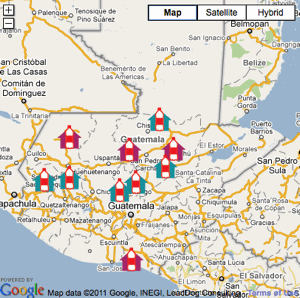
Locations of bottle schools in Guatemala. (Photo: Hug it Forward)
GELLERMAN: Well, Laura, thank you very much, really appreciate it.
KUTNER: Thank you for having me.
GELLERMAN: Laura Kutner recently returned from Grenados, Guatemala, where she served in the Peace Corps.
Related link:
Click here for more information on how you can donate to bottle schools in Guatemala.
[MUSIC: KJ Denhardt “Message In A Bottle” from Dal Vivo A Umbria Jazz (Motema Music 2008).]
Science Note
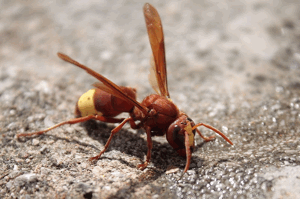
The Oriental Hornet. (Photo: Matti Paavola- Wikimedia Creative Commons)
GELLERMAN: Coming up – oceanography and poetry. I think I shall never see….a poem lovely as the sea. But first, this note on emerging science from Wynn Tucker.
[MUSIC: GREEN HORNET THEME]
TUCKER: Another challenge for the Green Hornet: harness the awesome power of the sun.
[SCIENCE NOTE THEME]
TUCKER: A new kind of ‘green hornet’ has caught the attention of scientists at Tel Aviv University. The Oriental Hornet can be found from the Middle East to India, and it has the ability to convert sunlight into energy. Unlike other flying insects, this hornet is most active during the middle of the day, when the sun shines the brightest. Scientists discovered that its body acts as a solar panel.

The Oriental Hornet. (Photo: Matti Paavola- Wikimedia Creative Commons)
The exoskeleton of the oriental hornet is brown with a ring of yellow around its abdomen. The brown section of the exoskeleton is covered with tiny grooves that trap light. The yellow ring gets its color from a pigment called Xanthopterin, which converts the sunlight into energy.
The hornet uses this energy to build its nest. Researchers hope to apply the structure of the hornetÂ’s exoskeleton to solar panels. If this does lead to a more cost-effective solar panel, the oriental hornet could take the sting away from the high prices of solar technology.
ThatÂ’s this weekÂ’s Note on Emerging Science, IÂ’m Wynn Tucker.
Related link:
The original paper as published in the journal Naturwissenschaften
GELLERMAN: You can hear our program anytime on our website, or get a download for your MP3 player - the address is LOE dot org, thatÂ’s L-O-E dot O-R-G. There youÂ’ll also find pictures and more information about our stories. And, weÂ’d like to hear from you. You can reach us at comments at LOE dot org, once again, comments at L-O-E dot O-R-G, and you can call our listener line at 800-218-9988, thatÂ’s 800-218-9988.
[MUSIC: Perculator “Poetry Of Mice And Men” from Apple Tea? Why Not, Come On. (Dbut Records 2005).]
The Poetry of the Ocean

One of John Delaney's favorite haikus is by the 17th-century Japanese poet Matsuo Basho. (Ed Jansen)
GELLERMAN: The language of the scientist is factual. The words of the poet: metaphorical. But letÂ’s not be so strictly categorical - for rhyme and reason fused can be formidable. Oceanographer John Delaney waxes scientific and poetic at the University of Washington. Reporter Ari Daniel Shapiro has - his chapter, and verse.
SHAPIRO: Last year at a workshop for the Ocean Observatories Initiative in Baltimore, John Delaney huddled with Susumu Honjo during an evening reception. Honjo is an oceanographer at the Woods Hole Oceanographic Institution. He and Delaney were discussing a haiku written by Matsuo Basho, a 17th-century Japanese poet.

One of John Delaney's favorite haikus is by the 17th-century Japanese poet Matsuo Basho.
(Photo: Ed Jansen)
[CROWD TALKING INCOHERENTLY IN BACKGROUND]
HONJO: But let’s go with it, ok? Araumiya.
DELANEY: Araumiya.
HONJO: Ok, there are two things: intonation, which is go up and down very slightly…
SHAPIRO: This is one of Delaney’s favorite haikus.
HONJO: And also important thing is thereÂ’s a pause. If you go without a pause, it doesnÂ’t mean too much. If you leave the pause too long, it looks like you are hesitating. And, you generally learn itÂ…
DELANEY: (Laughs.)Â…by doing it.
HONJO: By doing it. Ok: Araumiya
Sado ni yokotau
Amanogawa
DELANEY: Araumiya
Sado ni yokotau
Amanogawa
HONJO: Good! Perfect, perfect, perfect, perfect.
SHAPIRO: The haiku, it means: Turbulent the sea
Stretching across to Sado Island,
The Milky Way.
HONJO: For us, for many people, that really symbolized not only the Earth, not only the water, not only the dark sky, but itÂ’s a whole universe!
DELANEY: Absolutely. And another way of thinking about it, “Turbulent the sea” means the ocean is very disturbed. Big waves. Breaking on the beach. And yet, referring to the Milky Way stretching across to Sado, it’s quite clear that the clouds have passed away, so there’s no storm at the moment. And yet the sea has a memory and it’s still turbulent. And so in 17 syllables in Japanese, Basho captured the absolute essence of the moment.
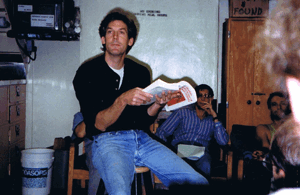
Poet Michael Collier. Poetry readings have become a ritual aboard Delaney's research cruises.
(Photo: Veronique Robigou)
SHAPIRO: For Delaney, the ocean is both a source of intellectual curiosity and emotional possibility. Science speaks to the intellect, he says, whereas poetry speaks to both the intellect and the emotion.
Michael Collier is a professor of English and creative writing at the University of Maryland College Park. HeÂ’s a poet too, and back in 1991, Delaney invited Collier to join him aboard the Atlantis II on one of his research cruises.
COLLIER: John just had this sense that having a poet onboard would bring another kind of element, a different kind of way of looking at the world.
SHAPIRO: Collier’s time aboard inspired him to write two poems later – one called “Fathom and league” and the other “Pax geologica.” He also read his poetry during the cruise, and it was the beginning of a tradition. On every research cruise since, one night has been devoted to poetry. Scientists, students and crew gather in the library to read aloud their own poetry or the poems of others. It’s become one of the best-attended and most eagerly anticipated events of every cruise.
Naturally, there’s also a lot of science happening onboard these cruises. For almost two decades, Delaney’s been pushing for a new kind of ocean science – a way of being there in the volume of the ocean without actually being there. It involves lighting up the ocean with an extensive network of sensors and semi-autonomous robots that can be reprogrammed from shore via high speed optical networks.
DELANEY: This Ocean Observatory Initiative will have thousands of sensors distributed through the volume of the ocean that will ever be on guard. I mean, 24/7/365 for decades, weÂ’ll be measuring the ocean from the inside out all the time.
SHAPIRO: This vision - it received funding from the National Science Foundation in September 2009. And itÂ’s only three years away from becoming a reality where these sensors monitor the physics, chemistry and biology of the ocean and seafloor in many locations across the world.
DELANEY: Humans will be intimately involved and tied to the oceans on a routine, regular basis in ways that we can’t even imagine right now. We will have the capacity to detect and track major events like a gigantic storm, or an erupting volcano, or migrating blue whales, or fish stock migration patterns, or for that matter – it could easily be big earthquakes and the tsunamis they generate. The more we know, the more wisely we can use and protect ourselves from the ocean.
SHAPIRO: This vision - it represents a democratization of science since these observatories will relay their data about the worldÂ’s ocean to anyone with an Internet connection. To scientists and, for that matter, poets too. On that research cruise almost 20 years ago, poet Michael Collier came to realize the connections between science and poetry.
COLLIER: One of the big connections is just experimenting. Poetry is experimenting with language, and science is experimenting with, you know, concepts. And then, also, theyÂ’re both very powerful forms of human inquiry and they both lead to different kinds of truth.

John Delaney finds poetic inspiration gazing at the ocean during a research cruises.
SHAPIRO: Delaney shares his love of poetry with other scientists too. Take Margaret Leinen, the associate provost at Florida Atlantic University. She met Delaney on a research cruise back in the early 80s, and theyÂ’ve stayed in touch ever since.
LEINEN: Whenever he is in town, IÂ’ve often got something new that I have to read to him.
SHAPIRO: For exampleÂ…
LEINEN: This is a poem by Ted Koozer who won the Pulitzer Prize for poetry. This poem is called “A Jar of Buttons.”
This is a core sample
from the floor of the Sea of Mending,
a cylinder packed with shells
that over many years
sank through fathoms of shirts –
pearl buttons, blue buttons –
and settled together
beneath waves of perseverance,
an ocean upon which
generations of women set forth,
under the sails of gingham curtains,
and, seated side by side
on decks sometimes salted by tears,
made small but important repairs.
SHAPIRO: For John Delaney, the ocean is full of mystery. And ocean observatories are a powerful way of weaving together the scientific and aesthetic threads that make up the fabric of our global ocean, and then streaming it all back to shore for everyone to absorb, read, pore over, and find meaningÂ…whatever their specific focus may be.
DELANEY: It gives us all the opportunity to experiment, to innovate, to develop novel approaches to studying the global ocean, which is really our life support system on the planet. ItÂ’s nothing more and nothing less. ItÂ’s the complexity that is going to be the biggest nut for us to crack. And itÂ’s not gonna yield easily to casual effort. ItÂ’s gonna be a major, major challenge for us to get there.
SHAPIRO: For Living on Earth, IÂ’m Ari Daniel Shapiro.
GELLERMAN: Our story about the poetry of the sea comes to us courtesy of Ocean Gazing Podcast. ItÂ’s produced by the Centers for Ocean Sciences Education Excellence, with support from the National Science Foundation. For more information on Ocean Gazing, take a gander at our website loe.org.
[MUSIC: Jeannie Bryson “Poetry Man” from Deja Blue (Koch Jazz 2001).]
Related links:
-
- Ocean Gazing
- Interactive Oceans
- Michael Collier's wikipedia page
-
GELLERMAN: On the next Living on Earth: a nightmare scenario - a severe drought in China sends wheat prices soaring and buyers trying to gobble up the US crop.
BROWN: Now you can say well, if they drive up our food prices too much we'll restrict exports. But China's our banker; they're holding 900 billion dollars in US treasury securities.
GELLERMAN: Global food insecurity - a shortage of rain and a shortage of grain - next time on Living on Earth.
[SOUNDS OF BISON]
GELLERMAN: We leave you this week in the company of wild bison.
[BISON NOISES]
GELLERMAN: Antelope Island State Park in Utah, is home to 600 American buffalo. They’re usually free to roam - but on this day, they were in corrals after the annual roundup to check on their health.
Under skies we hope were not cloudy, producer Jeff Rice was able to get up close to these wooly bullies. He recorded their grumblings for the University of Utah Marriott Library, westernsoundscape.org.
[SOUNDS OF THE AMERICAN BUFFALO]
(EARTHEAR RELATED LINKS:
The Institute of Museum and Library Services funds the Western Soundscape Archive: http://www.imls.gov/
Visit the Western Soundscape Archive: westernsoundscape.org)
GELLERMAN: Living on Earth is produced by the World Media Foundation. Our crew includes Bobby Bascomb, Eileen Bolinsky, Ingrid Lobet, Helen Palmer, Jessica Ilyse Smith, Ike Sriskandarajah, Mitra Taj, and Jeff Young, with help from Sarah Calkins, and Sammy Sousa. Our interns are Sean Faulk and Wynn Tucker. Jeff Turton is our technical director. Alison Lirish Dean composed our themes. You can find us anytime at LOE dot org – and while you’re online, check out our sister program, Planet Harmony. Planet Harmony welcomes all and pays special attention to stories affecting communities of color. Log on and join the discussion at my planet harmony dot com. And don’t forget to check out the LOE Facebook page, it’s PRI’s Living on Earth. Steve Curwood is our executive producer. I'm Bruce Gellerman. Thanks for listening!
ANNOUNCER 2: Funding for Living on Earth comes from the National Science Foundation, supporting coverage of emerging science, and Stonyfield Farm, organic yogurt and smoothies. Stonyfield pays its farmers not to use artifical growth hormones on their cows. Details at Stonyfield dot com. Support also comes from you, our listeners, the Ford Foundation, the Town Creek Foundation, the Oak Foundation supporting coverage of climate change and marine issues, the Bill and Melinda Gates Foundation, dedicated to the idea that all people deserve a chance to live a healthy, productive life. Information at Gates Foundation dot org. And Pax World Mutual Funds integrating environmental, social and governance factors into investment analysis and decision making. On the web at Pax World dot com. Pax World, for tomorrow. PRI, Public Radio International.
Living on Earth wants to hear from you!
Living on Earth
62 Calef Highway, Suite 212
Lee, NH 03861
Telephone: 617-287-4121
E-mail: comments@loe.org
Newsletter [Click here]
Donate to Living on Earth!
Living on Earth is an independent media program and relies entirely on contributions from listeners and institutions supporting public service. Please donate now to preserve an independent environmental voice.
NewsletterLiving on Earth offers a weekly delivery of the show's rundown to your mailbox. Sign up for our newsletter today!
 Sailors For The Sea: Be the change you want to sea.
Sailors For The Sea: Be the change you want to sea.
 The Grantham Foundation for the Protection of the Environment: Committed to protecting and improving the health of the global environment.
The Grantham Foundation for the Protection of the Environment: Committed to protecting and improving the health of the global environment.
 Contribute to Living on Earth and receive, as our gift to you, an archival print of one of Mark Seth Lender's extraordinary wildlife photographs. Follow the link to see Mark's current collection of photographs.
Contribute to Living on Earth and receive, as our gift to you, an archival print of one of Mark Seth Lender's extraordinary wildlife photographs. Follow the link to see Mark's current collection of photographs.
 Buy a signed copy of Mark Seth Lender's book Smeagull the Seagull & support Living on Earth
Buy a signed copy of Mark Seth Lender's book Smeagull the Seagull & support Living on Earth

